Pigeons, commonly found in urban environments around the world, are fascinating creatures with their own unique set of behaviors and communication methods. One aspect of pigeon behavior that intrigues observers is their body language, particularly when it comes to displaying aggression.
Understanding pigeon body language – aggressive behavior can provide valuable insights into their social dynamics and help humans interact more safely and harmoniously with these birds.
Aggression is a natural behavior observed in many animal species, and pigeons are no exception. Like other birds, pigeons use body language as a means of communication, and certain physical cues can indicate their aggressive intentions.
By learning to read and interpret these signals, we can better understand their behavior and avoid potential conflicts.
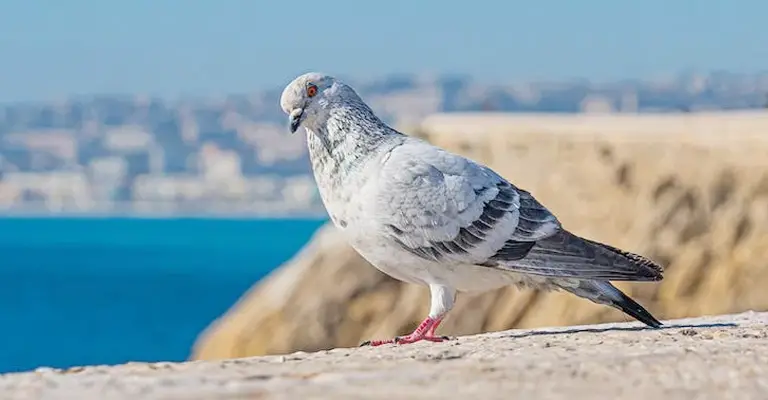
Pigeon Body Language – Aggressive Behavior
Here are some key elements of pigeon body language that indicate aggressive behavior:
Puffed-up Feathers
When a pigeon is feeling threatened or aggressive, it may puff up its feathers to appear larger and more intimidating. This visual display is a common tactic used to establish dominance and deter potential rivals or threats.
Head Bobbing
Pigeons often engage in head bobbing, especially during territorial disputes or when defending their nests. A quick, repetitive up-and-down movement of the head is a clear sign of aggression and serves as a warning to other pigeons to stay away.
Wing Flapping
Another visible display of aggression in pigeons is rapid wing flapping. This behavior is often accompanied by a loud clapping sound created by the rapid movement of the wings against the body. Wing flapping is used to assert dominance and intimidate other pigeons.
Tail Fanning
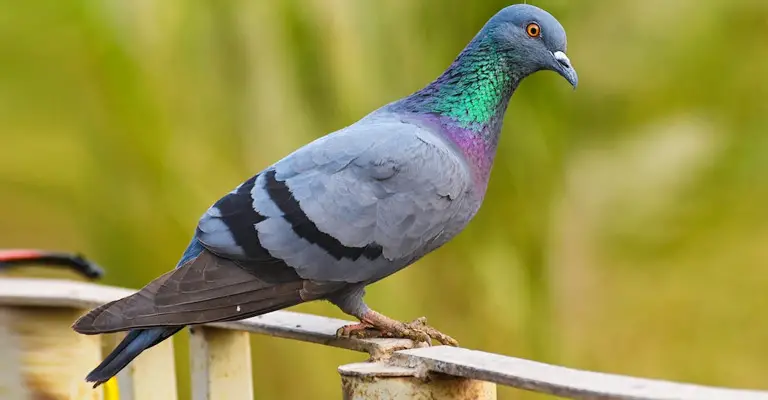
Pigeons may fan out their tail feathers as a visual display of aggression. This behavior is commonly observed during confrontations between individuals or when pigeons are protecting their territory or mate. The fanned tail serves as a warning sign and communicates the bird’s readiness to defend itself.
Charging and Lunging
In extreme cases of aggression, pigeons may charge or lunge at perceived threats. This aggressive behavior is typically accompanied by rapid movements, including wing flapping and vocalizations, aimed at intimidating rivals or intruders.
It’s important to note that pigeons generally display aggression towards their own kind, primarily during disputes over territory, mates, or food resources.
However, in urban environments where pigeons frequently interact with humans, it is essential to understand their body language to prevent any potential conflicts or harm.
If you encounter an aggressive pigeon, it’s best to give it space and avoid provoking or antagonizing it further. By calmly and slowly moving away, you can reduce the chances of escalating the situation.
Feeding or attempting to touch an aggressive pigeon may exacerbate its behavior, so it’s advisable to maintain a respectful distance.
It’s worth mentioning that some pigeon populations have become habituated to human presence and may display less aggression. In such cases, it is still important to be cautious and respectful of their space, as they are wild animals with their own natural behaviors and instinct.
The Significance of Some Behavior Patterns of Pigeons
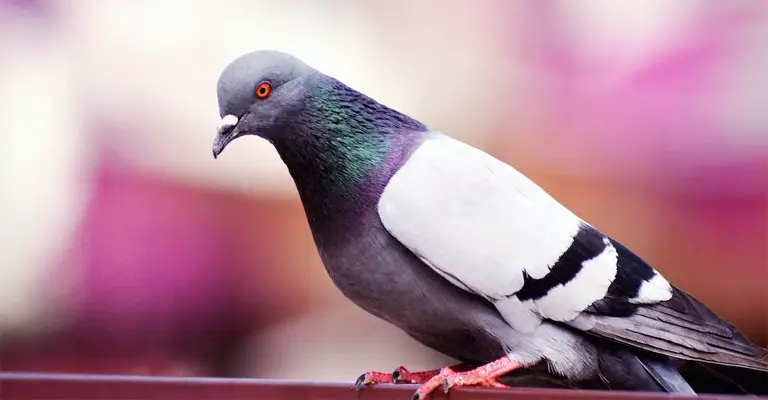
Behavior patterns in pigeons serve various purposes and have a significant significance in their lives. Understanding these behaviors can provide valuable insights into their communication, social dynamics, and survival strategies.
Here are some significant behavior patterns observed in pigeons:
Courtship Displays
Pigeons engage in elaborate courtship displays to attract a mate. These displays often involve puffing up their feathers, cooing, bowing, and engaging in ritualized movements such as turning in circles or bobbing their heads.
Courtship displays are important for pair bonding and selecting suitable mates.
Nesting Behavior
Pigeons exhibit specific nesting behaviors when preparing to reproduce. They search for suitable nesting sites, collect nesting materials like twigs and leaves, and construct nests.
Pigeons are known to be monogamous, and both males and females participate in nest-building and incubating eggs.
Homing Instinct
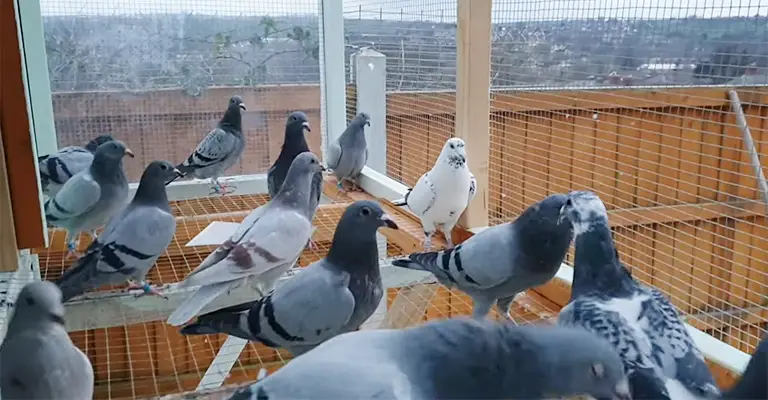
Pigeons have an exceptional ability to navigate and find their way back to their home or roosting site. This remarkable homing instinct has been exploited for centuries by humans, particularly in pigeon racing and messenger pigeon activities. The exact mechanisms of their navigational abilities are still not fully understood.
Flocking Behavior
Pigeons are highly social birds and often form large flocks. Flocking provides several advantages, including increased protection against predators, enhanced foraging opportunities, and improved communication. Flocking behavior also facilitates information sharing about food sources and suitable habitats.
Parental Care
Pigeons exhibit dedicated parental care. Both parents take turns incubating the eggs and feeding the chicks. They produce “pigeon milk,” a highly nutritious secretion from their crop, which is regurgitated and fed to the young ones.
Parental care ensures the survival and development of the offspring.
Preening
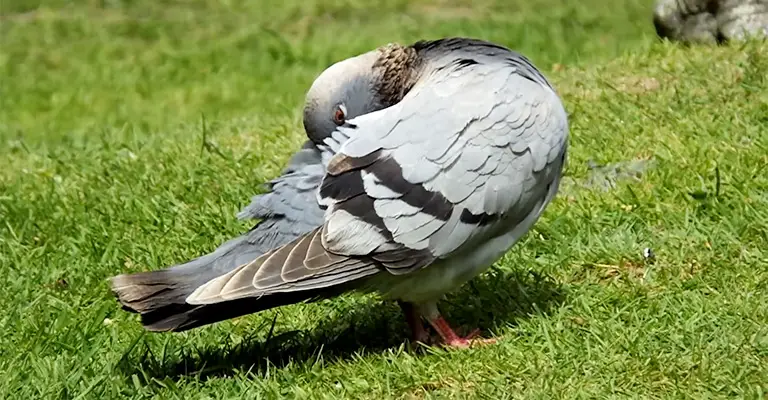
Preening is an essential behavior in pigeons. They use their beaks to clean and maintain their feathers, removing dirt, and parasites, and aligning the feathers for optimal insulation and flight performance.
Preening also helps distribute natural oils that waterproof and condition the feathers.
Foraging and Feeding
Pigeons are opportunistic feeders and can adapt to various food sources. They forage on the ground, scavenging for seeds, grains, insects, and other food items. Their ability to find food in urban environments has contributed to their successful adaptation to urban habitats.
Roosting
Pigeons have specific roosting sites where they gather and rest, typically in large numbers. These roosting sites, such as buildings, ledges, or trees, provide shelter and safety from predators.
Roosting in groups also allows pigeons to exchange information and maintain social bonds.
Sun Bathing
Pigeons often engage in sunbathing behavior, where they expose themselves to sunlight, usually by stretching out their wings and basking in the warmth. Sunbathing is believed to help regulate their body temperature, dry damp feathers, and potentially aid in the synthesis of vitamin D.
Mating and Pair Bonding
Pigeons engage in elaborate courtship rituals to attract and bond with their mates. Once a pair bond is established, pigeons often stay together for life. Strong pair bonds contribute to successful reproduction and the raising of offspring.
Cooing and Cooing Displays
Pigeons are known for their cooing vocalizations, but during aggressive encounters, their coos can take on a different tone.
Aggressive cooing is often more intense and may be accompanied by the fluffing of feathers and other aggressive body language cues.
Pecking and Biting
Pigeons may resort to pecking or biting when they feel threatened or are engaged in a territorial dispute. Aggressive pecking can be directed toward other pigeons, humans, or even objects that are perceived as a threat.
Chasing and Pursuing
When pigeons engage in chasing or pursuing behavior, it is a clear sign of aggression. This behavior is often seen when pigeons are competing for resources or defending their territory. The pursuing pigeon will chase the other bird, often accompanied by aggressive vocalizations.
Raised Wings
Pigeons may raise their wings in an aggressive display, especially when they feel their territory or personal space is being invaded. This posture makes them appear larger and more threatening to potential rivals or intruders.
Bowing and Nodding
Pigeons may engage in bowing and nodding behaviors as part of their aggressive displays. They will lower their heads towards the ground, often coupled with head bobs, to assert dominance and intimidate other pigeons.
Stomping
Pigeons may stomp their feet on the ground when they are feeling agitated or aggressive. This behavior is often accompanied by other aggressive cues such as cooing, head bobbing, or wing flapping.
Sideways Stance
When a pigeon adopts a sideways stance, where its body is turned to the side, it is a sign of aggression. This posture allows the pigeon to present a narrower profile, making it appear more threatening to its opponent.
By familiarizing ourselves with pigeon body language and understanding their aggressive behaviors, we can coexist with these urban-dwelling birds more harmoniously and appreciate the remarkable ways they communicate and interact with their environment.
Understanding these behavior patterns provides valuable insights into the lives of pigeons and helps us appreciate their remarkable adaptations and social structures.
How to Prevent Aggressive Behavior in Birds?
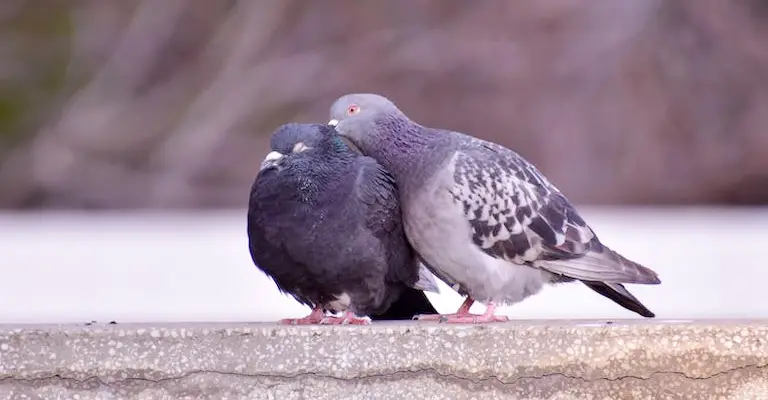
Preventing aggressive behavior in birds, including pigeons, requires understanding their needs and providing a suitable environment. Here are some strategies to help minimize aggression in birds:
Sufficient Space
Birds need ample space to fly, exercise, and establish their territory. Ensure that the bird’s enclosure or living area is appropriately sized to accommodate their natural behaviors and flight requirements. Providing enough space can help reduce territorial conflicts and aggression.
Enrichment
Enrichment activities are essential to keep birds mentally stimulated and engaged. Offer a variety of toys, perches, and objects for birds to explore, play with, and manipulate.
Mental and physical stimulation can alleviate boredom and prevent aggressive behaviors that may arise from frustration.
Socialization
Many bird species are highly social and require companionship. If possible, consider providing your bird with a suitable companion of the same species.
However, it’s crucial to research and ensure compatibility between individuals before introducing them. Socialization with other birds can help prevent loneliness and aggression stemming from isolation.
Proper Nutrition
A balanced and nutritious diet is essential for a bird’s overall health and behavior. Ensure that your bird receives a diet appropriate for its species, including a variety of fresh fruits, vegetables, seeds, and pellets. Proper nutrition can contribute to their well-being and help reduce stress-related aggression.
Consistent Routine
Establishing a consistent daily routine can create a sense of security for birds. Maintain regular feeding times, play sessions, and sleep schedules. Predictability and structure in their daily lives can minimize stress and prevent aggressive behaviors caused by anxiety or uncertainty.
Positive Reinforcement Training
Positive reinforcement training techniques can be used to shape desired behaviors in birds. Reward-based training methods, such as clicker training, can help birds learn new behaviors and redirect aggression into more appropriate activities.
Consult with an avian behavior specialist or a knowledgeable bird trainer for guidance on training techniques.
Environmental Stimulation
Birds thrive in environments that resemble their natural habitats. Provide natural elements such as branches, foliage, and safe outdoor exposure (supervised and protected) to stimulate their senses and encourage natural behaviors.
Mimicking their natural environment can reduce stress and promote healthier behavior.
Veterinary Care
Regular visits to an avian veterinarian are crucial to maintaining a bird’s health. Ensure your bird receives routine check-ups, vaccinations, and necessary medical treatments.
Illness or pain can contribute to aggression, so prompt veterinary care can help identify and address any underlying health issues.
Avoid Reinforcing Aggression
It’s important not to inadvertently reinforce aggressive behaviors. Avoid rewarding or reinforcing aggression through attention, treats, or other positive stimuli when the bird displays aggressive behavior. Instead, redirect their focus to more appropriate activities and reinforce positive behaviors.
Patience and Understanding
Each bird is unique, and it may take time to understand its individual needs and behavior patterns. Patience, observation, and a willingness to learn about their species-specific behaviors will help you better address and prevent aggression.
Remember, aggression in birds can have various underlying causes, including hormonal changes, fear, stress, or insufficient environmental enrichment.
If you’re experiencing persistent or severe aggression issues with your bird, it’s advisable to consult with an avian behavior specialist who can provide tailored guidance and support.
FAQs
Pigeons bob their heads as a natural behavior associated with their vision. Unlike humans, pigeons lack the ability to move their eyes in their sockets, so they compensate by moving their heads in a rhythmic up-and-down motion.
Cooing is a common vocalization in pigeons and serves multiple purposes. Male pigeons often coo to attract mates during courtship displays. Additionally, cooing can be a form of communication between pigeons, used to establish territories, signal contentment, or communicate with their flock.
Puffing up their feathers, also known as “displaying,” is a behavior seen in pigeons when they feel threatened, agitated, or are trying to establish dominance. By puffing up their feathers, pigeons appear larger and more intimidating to rivals or potential threats, potentially deterring aggression.
Pigeons fly in flocks primarily for safety and social benefits. Flocking provides protection against predators as larger groups make it more difficult for a predator to single out an individual pigeon. Flocking also facilitates information sharing about food sources and suitable roosting sites, as well as providing a sense of social cohesion and companionship.
Pigeons have a strong homing instinct and an attachment to their roosting sites. They return to these locations for several reasons. Roosting sites provide shelter, protection from predators, and a familiar environment where pigeons can rest, groom, and interact with other members of their flock.
Final Words
That was all about pigeon body language – aggressive Behavior. Understanding pigeon body language and recognizing the signs of aggression can enhance our interactions with these fascinating birds.
By respecting their boundaries and avoiding confrontations, we can coexist harmoniously in urban environments where pigeons have become a familiar sight.
Remember, observing from a safe distance and appreciating their beauty and uniqueness from afar is often the best approach to enjoying these remarkable creatures.